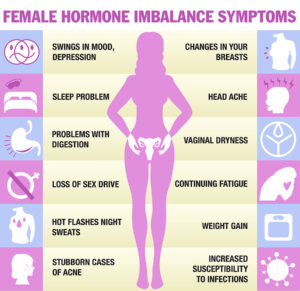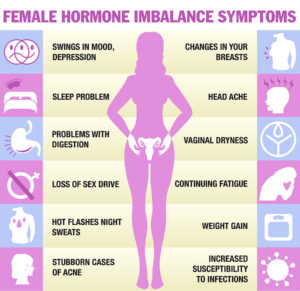At the 30th A4M Conference mid-December Dr. Anna Cabeca lectured about “Help with menopausal symptoms”. A4M stands for “Conference of the American Academy of Anti-Aging Medicine”. It is a yearly event at the Sand Conference Center of the Venetian Palace in Las Vegas. The following is a summary of the very detailed lecture by Dr. Anna Cabeca.
Definition of postmenopausal symptoms
Dr. Cabeca’s detailed title for her lecture was: “Menopause: Hot flashes, brain fog and vaginal dryness; 3 symptoms women don’t have to experience.” The first thing to remember is this detailed list of symptoms of menopause:
- Hormones are disbalanced
- Unusual behaviors and moodiness
- Gaining weight (accumulating fat)
- Tiredness
- Loss of willpower
- Sleep disturbance: can’t sleep or sleeps all the time
- Brain fog and memory problems
- Lost your “edge”
- No sex drive
- Aging rapidly
- Hair loss
- Thyroid problems
- Hysterectomy (to remedy excessive periods)
Hormone changes with menopause
To clarify, there are major hormone changes with menopause as follows. To explain, at the age of 35 progesterone suddenly experiences a major reduction, which completes by the age of 45. In contrast, estrogen levels remain high until the age of 40 when it, too is reduced to background activity by the age of 50. In fact, at this point estrogen production is still more than progesterone synthesis. This is the basis of what is called estrogen dominance.
In general, symptoms of estrogen dominance are: PMS, hot flashes, night sweats, mood swings, weight gain, vaginal dryness, brain fog, irregular periods, less libido, missing or increased periods, bone loss and sleep disturbance.
To emphasize, the production of male hormones, DHEA and testosterone, slows down around the age of 30 and reaches a low plateau around the age of 45. This explains, for example, the lack of sex drive mentioned above. In addition, it is also partially responsible for brain fog, tiredness, hair loss and unusual behaviors and moodiness.
Perimenopause and menopause increase risk for diabetes
By all means, there is a clear relationship between age and the risk of developing diabetes in both males and females. But it must be remembered that the hormone weaknesses in combination with weight increases can also trigger diabetes.
Head-to-toe patient work-up
There are two parts to a patient’s work-up, a thorough assessment and a patient’s education.
The patient’s assessment includes:
- Energy, mind, spirit
- Hormone balance
- Inflammation
- Assessment of diet and nutritional intervention
- Gastrointestinal health and digestion
- Detoxification
- Structural investigation
Surely, another key point is that patient education is important to be successful in the multiple step intervention to normalize the metabolism, shed excessive weight and help the patient to refocus.
Comments to the patient’s assessment
Indeed, the display of energy in a patient is closely related to hormone balance. Notably, when hormones are measured and they are out of balance, this usually explains the multiple symptoms. It is important to realize that inflammation is measured with the high-sensitivity CRP blood test. This test measures the level of inflammation. Initially, the level may be 30, but with weight loss it often normalizes with values of 2 or 3. At the same time weight loss stabilizes blood sugar (indicated by an initially high, but later normalizing hemoglobin A1C) and diabetes can completely disappear. Frequently, an analysis of the diet often shows that the patient is eating too much sugar and starchy foods.
Faulty nutrition, heavy metals and osteoporosis
In addition, many patients also eat too much meat and processed meat products, which leads to elevated cholesterol and triglycerides. Also, introducing more vegetables and fruit reduces lipids in the blood. Certainly, patients’ blood tests often show high levels of heavy metals like mercury, lead and cadmium. This can be chelated out with intravenous EDTA. Often 6 treatments at weekly intervals will rid the body of these toxins from pollution and the consumption of fish that has high mercury content.
Structural investigation of the bone with bone density measurements can diagnose osteoporosis. An initial remedy for this is supplementation with 5000 IU of vitamin D3 and vitamin K2 200 micrograms daily.
Low carb diet can help rebalance body metabolism
People who are overweight or obese get metabolic changes in their blood that physicians call metabolic syndrome. It raises blood pressure, often leads to elevation of cholesterol, triglycerides and blood sugars and also causes inflammation. A diet like the Mediterranean diet can help stabilize the metabolism. Dr. Anna Cabeca recommended a ketogenic diet, but from my reading a Mediterranean diet will achieve the same. In addition, a ketogenic diet carries a higher risk of heart attacks and strokes. For this reason I cannot recommend a ketogenic diet. The end result is an improvement of organ function, improvement of blood tests and less reliance on medications. Our body simply performs and functions better.
Fasting improves mitochondrial health
Mitochondria are small particles inside the plasma of all the body cells. Their functioning is essential for our energy and for cell metabolism in all of our organs. The energy, which is produced by the mitochondria is stored in a small molecule, called adenosine triphosphate or ATP. I discussed earlier that heavy metals must be removed from the body by chelation therapy. One known effect of heavy metals is the poisoning of mitochondria. A person who has high blood levels of heavy metals in the body complaints of low energy and brain fog. After several intravenous chelation treatments, the energy returns and the brain fog disappears.
The fasting mimicking diet of Dr. Valter Longo is another tool to reactivate mitochondria.
Bioidentical hormone replacement
Many postmenopausal women require some help with regard to their hormonal balance. There are doctors who specialize in this area. They order a baseline panel of hormones. If there is a lack of progesterone, they order bioidentical hormone replacement, a hormone cream that the patient applies herself to the forearm or abdomen. Hormone saliva tests must show a ratio between progesterone and estrogen of 200 to 1 or higher. Many women have too much estrogen in their system relative to progesterone. By balancing this hormone ratio, the risk of getting cancer from estrogen that is not in balance experiences a significant reduction. The patient will also feel more energy and sleep better.
Conclusion
Menopause does not have to be the dreaded time in a woman’s life, when her periods stop. With a bit of attention to her nutrition, her hormone balance and other symptoms the physician can help her experience none of the symptoms. It will require some hormone and other blood tests. It may also require some detoxification with intravenous EDTA infusions. At the end that postmenopausal patient will feel energy again, clear up her foggy brain and sleep better. In addition, the woman will regain her sex drive and feel more energy. The physician treats estrogen dominance by adding progesterone cream supplementation. This also assist with regard to sleeping better.
It does take the effort to have all the necessary blood tests and saliva tests to establish deficiencies. A physician who has experience in anti-aging medicine will be of important help to bring a menopausal patient back on the road to wellness.








